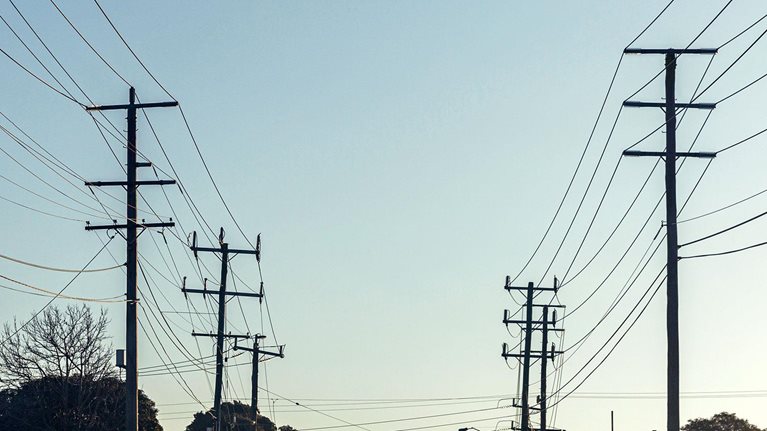Globally, the electricity grids that power the economy are undergoing rapid and profound change. In the United States, policies supporting decarbonization and increasingly cost-competitive renewable resources are transforming the generation stack, with nearly 100 gigawatts (GW) of wind and solar added between 2017 and 2022, a record 32 GW of solar likely to be added in 2023 alone, and nearly 2 terawatts (TW) of capacity in the interconnection queue.1 At the same time, building and transport electrification are adding to demand pressure on these grid networks.
Climate risks, including wildfires and severe storms, are on the rise in many geographies, placing additional stress on communities and the power infrastructure that serves them.2 Extreme heat is increasing cooling demand while reducing the efficiency of grid infrastructure. Minnesota, for example, could see a 75 percent increase in extreme heat days over the next decade, equivalent to current levels in Ohio.3
Thunderstorms also pose a challenge for grid operators. In New Jersey, for example, where such storms already cause around 80 percent of major outages, the number of thunderstorm-risk days per year is expected to rise by more than two-thirds by 2050.4
Such risks come amid heightened concern around affordability, aging infrastructure, and surging inflation, all which have elevated the cost of core essentials by a fifth since 2021.5
Altogether, the challenge of providing safe, reliable, resilient, and affordable power—all while enabling the energy transition—is forcing grid planners to reimagine their processes and rethink longstanding paradigms for measuring and managing performance.
It will be incredibly difficult and inefficient to meet these needs independently. By adopting an integrated system planning approach, utilities can deliver all these outcomes supported by probabilistic analytical models and a granular, segment-specific view of future grid needs. The rewards of this shift could be significant: up to 20 percent capital efficiency, 15–30 percent reduction in major event outages, and a clearer pathway to achieving decarbonization milestones and goals.6 This article explores approaches for securing these gains.
Emerging challenges in distribution grids
Grid planning is becoming a critical strategic capability, requiring a combination of technology, expertise, and understanding of market trends. Future grid needs can only be met cost-effectively if utilities are able to model and assess key drivers including climate risks, asset health, and customer adoption of distributed-energy resources (DERs) (such as heat pumps and rooftop solar) collectively.
By building tech-enabled, integrated system planning capabilities, utilities can understand and quantify these challenges. Defining the full scope of grid needs is a necessary precursor to identifying cost-effective investment solutions, making it imperative to start building these capabilities now.
A suite of interconnected analytical models with circuit- or asset-level granularity can help grid planners manage growth, reliability, affordability, resilience, and flexibility (Exhibit 1). By providing practical insights into key planning questions, these models can be a critical tool for navigating uncertainty—for example, by identifying the optimal mix of vegetation management and undergrounding to hit resilience targets, or revealing where capacity expansion and undergrounding can be combined to drive costs down.

Climate risks and resilience
Climate-related hazards, which pose a growing threat to grid resilience, will evolve differently across geographies. For example, over the next decade, Kansas expects to see a 25 percent increase in extreme heat days, while a 29 percent increase in severe thunderstorm frequency is predicted for Colorado. Approximately 88 percent of the western part of the United States could be subject to at least 30 high Fire Weather Index days per year.7 Similarly, the likelihood of extreme precipitation and amplified urban growth are elevating flood risks and changing flood plains in some areas.
Broadly speaking, warming is increasing the frequency and intensity of extreme weather events in many areas, putting grid resources at heightened risk.8 In the United States, for example, “major events”—often involving extreme weather coupled with aging grid infrastructure—have caused annual power interruptions to rise in average duration from less than four hours in 2015 to more than seven hours in 2021.9
Higher peak temperatures pose substantial challenges for grid operators, impacting both peak loads and grid performance. Dallas, Texas, for example, could see the annual number of heatwave days almost triple, from an average of 25 days per year between 1975 and 2022 to 67 by 2050.10
Would you like to learn more about our Electric Power & Natural Gas Practice?
Recognizing these shifts, McKinsey has established an in-house Climate Analytics capability to translate the latest climate science into granular, investment-relevant insights (see sidebar “McKinsey’s Climate Analytics in the utility industry”).
Historically moderate climates could be affected, too. In an analysis for a Midwestern utility, cooling degree days were predicted to rise by 30 percent over that same period.11 Grids will need to be prepared to meet demand increases from higher cooling loads, while also managing less efficient performance of essential equipment under extreme heat. Power line losses increase at higher temperatures, with capacity dropping as much as 7 percent below normal design ratings when temperatures exceed 100° F—undermining grid performance precisely when customers need it most.12

There can be significant disparities in these hazards at a circuit level, even within small geographic areas (Exhibit 3). For example, when one Midwest utility examined the expected increase in severe convective storms over time, some circuits saw increases at quadruple the rate of others.13 Understanding the evolution of hazards circuit by circuit (as opposed to by state or region) will be critical for steering capital toward critical network segments.

Transition risks and grid constraints
There are multiple new, complex transition risks and constraints that grid planners must also take into account. These include electric vehicle (EV) adoption and usage; electrification of space heating and buildings; distributed-energy resource adoption and usage (for example, solar that is attached to storage versus unattached); and fundamental changes in demand due to economic shifts and new sources of demand (for example, data centers and AI).
While this article is focused on the distribution grid, there are multiple additional transition risks across the electric system—for example, generation assets can have significantly impaired performance under extreme temperature, which can create stress on the grid.
Many energy-transition scenarios project a significant increase in electrification and adoption of related technologies as countries reduce their reliance on fossil fuels. The rapid electrification of road mobility and varied deployment of distributed energy resources (such as at-home, at-work, managed, and unmanaged EV charging) create uncertainty around future load profiles. Recent research in California, for example, found that EVs can increase overall household load from 4.8 up to 14.0 kWh per charging event, depending on the type of vehicle. The impacts on distribution feeders varies materially, with feeders exceeding capacity thresholds by up to 300 percent and for as long as 22 hours.14
The adoption of distributed solar and batteries compounds this uncertainty. The United States has accumulated more than 32 GW of installed residential solar capacity and 17 GW of commercial capacity, and this is only expected to grow.15 These resources have the potential to help offset investments in grid capacity and management, but may also challenge grid stability and flexibility.
The electrification of heat is also noteworthy as it creates concentrated demand that frequently coincides with periods of low renewable generation (such as winter mornings). For the first time, annual heat pump sales in the United States rose above four million units in 2022, exceeding gas-powered furnaces—a trend likely to be accelerated by the Inflation Reduction Act’s support for home electrification.16 The United States is not alone in this trend: around the world, the energy crisis has driven heat pump sales to record levels, with sales in Europe climbing by nearly 40 percent from 2021 to 2022.17
The trend towards electrified heat could fundamentally transform seasonal load profiles. In select geographies, rapid heat-pump adoption could increase residential heating loads and shift traditionally summer peaking systems to winter peaking. In one utility’s territory, the share of winter peaking circuits could grow from less than 10 percent of total circuits to nearly 40 percent, with some circuits increasing peak hour winter load by as much as 80 percent (Exhibit 4).18 As more consumers rely on the electric grid to meet critical heating needs, grid operators will need to ensure the system is prepared to supply winter peak periods reliably.

An updated approach for an uncertain future
Longstanding tools and processes for managing grid performance are no longer up to the task. How grid operators move to address these challenges will attract public and regulatory scrutiny and have profound business implications, impacting operational performance directly.

Toward a more orderly US energy transition: Six key action areas
To get out in front of the problem, utilities may need to move further and faster than ever before, updating planning paradigms and making strategic investments in AI to support their processes. This can be achieved with four key shifts.
From siloed to integrated system planning. Historically, capital planning has been siloed—both across the value chain (for example, generation planning managed independently of distribution planning) and within specific programs (for example, vegetation management, undergrounding, and smart grids budgeted and planned separately).
Only by addressing grid issues holistically can utilities fully understand challenges and trade-offs across investments. When making planning decisions, they should simultaneously consider evolving climate risks, heightened electrification load, strategic constraints (such as budget and workforce capacity), and performance targets (including fleet electrification, reliability, performance, and resilience).
This will require a real shift in how planning happens, not only across generation, transmission, and distribution, but also across alternative energy systems (such as gas distribution infrastructure and transportation fuels). The grid needs of an electric system that powers dual-fuel air source heat pumps, for example, will be considerably different to one reliant on electric-only pumps.
From limited outcome quantification to clear performance outcomes tied to investment. Grid operators may need to look beyond traditional, blue-sky reliability and affordability measures and benchmarks to assess performance. The standard “non-MED” average outage duration for each customer served (SAIDI) and average interruptions per customer (SAIFI) metrics used today exclude major events—creating a disconnect between what grid planners are incentivized to solve and what matters most to customers. With impacts of major event days frequently treated as uncontrollable, utilities are typically only pushed to invest in resilience following major disasters (for example, hardening after Superstorm Sandy and hurricane hardening in Florida).19 This has largely remained the case even though the likelihood of these events is increasing.
Customers tend to be more heavily impacted by grey-sky outages due to longer average outage duration and the higher cost of restoring power. Their patience, however, is wearing thin, with leaders pushing for greater accountability. In Michigan, for example, extended outages driven by summer storms in 2021 led Governor Gretchen Whitmer to call for immediate action to harden the grid.20 Legislatures are also making moves. In Texas, for example, Act HB 2555 aims to streamline approval and cost recovery for transmission and distribution investments.21
Utilities may need to consider performance metrics that reflect the impact of heightened physical climate-change risks (for example, customers experiencing long interruptions or the percentage of customers offline), while planning for load shifts, like heat-pump adoption, stemming from decarbonization.
From a top-down, historical view of grid needs to a circuit- and segment-specific view of future needs. Traditionally, grid operators have relied on historical trends when planning for resilience challenges and load growth. With accelerating electrification and mounting climate hazards, grid operators can no longer rely on past trends. Instead, they need dynamic plans that account for emerging risks and rapid load shifts. This will require new, predictive modeling capabilities that inform planning horizons with granular insights. Service-territory-wide forecasts won’t identify the specific areas of the electric value chain that require the greatest investment.
From tiered risk models to granular “risk return on investment” modeling that drives integrated decision making. Utilities are moving away from more subjective, tiered risk ratings (for example, assigning assets a simple risk score) toward probabilistic risk assessments (for example, 20 percent likelihood of 100 customers experiencing an outage versus 30 percent likelihood of 50 customers experiencing an outage). The former can be useful for prioritizing capital within a budget, but doesn’t help decision makers determine whether an incremental dollar is better spent in one program or another.
Planners could seek to understand the expected benefits from each dollar of capital and operating expenditure invested based on a circuit or asset-level view of potential risk. They can leverage predictive models and AI to identify the highest-impact interventions (such as vegetation management or microgrid development) and prioritize capital allocation while managing affordability.
Calculating the risk return on investment
Prioritizing potential investments and communicating value to regulators and the public will require careful consideration of the risk return on investment. Grid planners have a range of tools at their disposal to tackle physical risk and transition-driven load growth challenges (see sidebar “Critical investment programs”). Understanding the cost-effectiveness of these programs can help with capital allocation decisions and ensure utilities are getting the most value for every dollar invested (Exhibit 5).

As grid planners prioritize these investments, a granular, circuit-specific view of system needs over time can provide insight into when and where intervention is required and help to determine the risk return on investment of each measure. Such geo-specific views are necessary for prioritizing capital within programs, too (Exhibit 6).

Climate risks and increasing decarbonization are driving both demand and uncertainty, creating unprecedented challenges for planners juggling resilience, reliability, flexibility, and affordability. Grid planning processes that worked in the past are becoming less effective, increasing risks and resulting in higher costs for customers. By managing and planning for these challenges, grid planners could catalyze the energy transition and deliver increased value to communities and customers.


